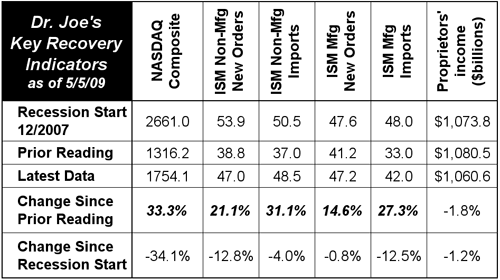Back in January, I outlined the reasons for selecting our “recovery indicators.” They include four indicators from the Institute for Supply Management (oldtimers will remember them as the National Association of Purchasing Managers), the NASDAQ index, and proprietor's income from the Bureau of Economic Analysis' reports of personal income and GDP.

The biggest gain since last month has been in the NASDAQ composite which is up almost one-third since last month. It has to go up more than 50% to get to the level it was at the designated start of the recession. That's a lot of ground to cover. Right now the stock markets have rebounded because people have realized that companies actually will make profits sometime in the future, and that many companies have reduced their costs enough that it will be sooner rather than later, for most sectors. There's still lots of climbing to do.
In the service sector, we had nice rebounds in new orders and imports. The ISM indices use 50 as the demarcation between growth and decline. We're still on the decline side, but we're getting very close to that 50 breakeven point. Imports are critical, despite misplaced common sentiment, because many raw materials and goods have to come in from overseas because that is where they are mined or otherwise created, just like in manufacturing.
On the manufacturing side, new orders were up as well, with imports improving, but still at a recessionary level. Manufacturing will be slow to recover as the supply chains to auto manufacturers are constrained by the lack of interest of consumers in buying new cars. This, too, shall pass. New manufacturing orders are very close to the December 2007 level.
We don't get a new proprietor's income figure until the end of May when the BEA releases the preliminary revisions to Q1 GDP and personal income. We have gotten minor updates to the Q4-08 data as the BEA refines its estimates. This is really important to watch because it is our best understanding of small business activity.
Note that unemployment is not part of the indicators. Unemployment will lag any recovery, as it always does. Businesses add hours to existing workers first, and only once they are convinced that an upturn will be sustained, will they add workers. The unemployment rate also worsens at a beginning of a recovery as the workforce becomes flooded with new and returning workers, often at a rate greater than the growth in new jobs. This means that the general economic news will still look bad even though the economy is in process of improving at tha time.
Despite the constant drone of the bad economic news, it is very important to remember the resiliency and dynamism of the U.S. economy. We should view it with a sense of awe and amazement. We will have problems going forward; keep an eye on commodities prices as that is where we will see signs of inflation first. It is possible that another oil bubble is ahead as the Federal Reserve will be reluctant to raise interest rates when that trend emerges.
Keep the economy in perspective: the better the economy does, the more investment in information technologies that can potentially avoid print, such as wider adoption of broadband, faster transmissions, and more new devices. Printers and vendors who are thinking that when the economy gets better that print will automatically get better should look at last week's ERC note.









